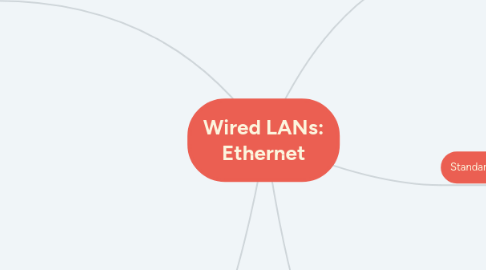
1. Fast Ethernet
1.1. MAC Sublayer
1.1.1. (half duplex with CSMA/CD) autonegotiation that allows two devices to negotiate the mode or data rate of operation
1.2. Phsical Layer
1.2.1. Reconciliation Sublayer ~replaces the PLS sublayer in 100Mbps Ethernet
1.2.2. Medium-Independent Interface ~replaces AUI in 100Mbps
1.2.3. PHY Sublayer ~the transceiver in fast Ethernet responsible for encoding and decoding
1.2.4. Medium-Dependent Interface ~hardware
1.3. Physical Layer Implementation
1.3.1. 100Base-TX ~uses 2 pairs of twisted cable in a physical star topology
1.3.2. 100Base-FX ~uses 2 pair of fibeer-optic cable in a physical star topology
1.3.3. 100Base-T4 ~uses 4 pairs of UTP for transmitting 100 Mbps
2. Ten-Gigabit Ethernet
2.1. MAC Sublayer
2.1.1. operates only in full duplex mode
2.1.1.1. 1000Base-T ~four-wire UTP
2.2. Physical Layer
2.2.1. designed for using fiber-optic cable over long distance
2.3. Physical Layer Implementation
2.3.1. 100Base-S ~Short-wave, 850-nm multimode
2.3.2. 100Base-L ~Long-wave 1310-nm single mode
2.3.3. 10GBASE-E ~Extended 1500-nm single mode
3. iEEE Standard
3.1. 1985- Project 802
3.2. Set standards to enable intercommunication
3.3. Way of specifying functions of the physical layer and the data link
4. Standard Ethernet
4.1. MAC Sublayer
4.1.1. Access Methods ~Traditional Ethernet()uses 1 persistent CSMA/CD
4.2. Physical Layer
4.2.1. Medium-Dependent Interface (MDI)
4.2.2. Physical Layer Signaling (PLS)
4.2.3. Attachment Unit Interface (AUI)
4.2.4. Medium Attachment Unit (MAU)
5. Gigabit Ethernet
5.1. higher data rate resulted in the design of the Gigabit Ethernet protocol
5.2. Physical Layer
5.2.1. 1000Base-SX ~two-wire short-wave fiber
5.2.2. 1000Base-CX ~two-wire copper (STP)

